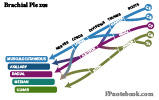II. Types
-
Upper Motor Neuron Lesion (everything is UP - tone, reflexes, toes)
- Muscle group weakness (not complete paralysis) and minimal Muscle atrophy
- Increased Muscle tone ("Clasp-knife" spasticity)
- Hyperreflexia with or without Clonus
- Babinski Reflex positive response
-
Lower Motor Neuron Lesion (everything is DOWN - tone, reflexes, toes)
- Flaccid Paralysis
- Muscular atrophy
- Muscle Fasciculations and fibrillations
- Hyporeflexia
- Absent Babinski Reflex
III. Exam: Muscle Strength Grading
- Grade 0: Total Paralysis
- Grade 1: Palpable or visible contraction
- Grade 2: Full range of motion with gravity eliminated
- Grade 3: Full range of motion against gravity
- Grade 4: Full range of motion with decreased strength
- Grade 5: Normal Strength
- NT: Not testable
IV. Exam: Rapid Motor Exam (Common and Important Motor deficits)
- Torso
- C3-4-5 keeps the diaphragm alive (Spontaneous Breathing)
- S2-3-4 keeps the stool off the floor (Reflex Defecation Center)
- Upper extremity
- Radial Nerve (C5-C6, C7-C8): Wrist Drop
- Dorsiflexion wrist, fingers against resistance (extensor carpi radialis, extensor digitorum)
- Median Nerve (C7, C8, T1): Cannot make 'OK' Sign
- Opposition of thumb and index finger against resistance
- Ulnar Nerve (C8-T1): Claw Hand
- Finger abduction against resistance
- Radial Nerve (C5-C6, C7-C8): Wrist Drop
- Lower extremity
V. Exam: Upper Extremity Strength
-

- C3-5: Spontaneous Breathing ("C3-4-5 keeps the diaphragm alive")
- C3-4: Trapezius function
- C5: Shoulder External Rotation (Infraspinatus)
- C5: Deltoid and Supraspinatus abduction at Shoulder (Axillary Nerve)
- C5-6: Biceps Flexion at Forearm (Musculocutaneous Nerve)
- C6: Forearm Supination (Radial Nerve)
- C6-7: Forearm Pronation (Pronator Teres; Median Nerve)
- C6-7: Wrist Extension (extensor carpi radialis brevis and longus; Radial Nerve)
- C7: Wrist Flexion (flexor carpi radialis brevis and flexor carpi ulnaris; Median Nerve and Ulnar Nerve)
- C7: Elbow Extension (Triceps, Radial Nerve)
- C7-8: Finger Extension (Extensor digitorum, extensor indicis, extensor digiti minimi; Radial Nerve - posterior interosseous)
- C7-8: Thumb Abduction (Abductor Pollicis Longus; Radial Nerve - posterior interosseous)
- C8: Thumb Extension and Adduction
- C8: Wrist Extension and incline ulnar aspect of hand (Extensor Carpi Ulnaris)
- C8: Fingers Flexion middle finger (flex dig profundus, Median Nerve)
- C8-T1: Thumb Flexion (flexor pollicis longus, Median Nerve - anterior interosseous)
- T1: Small finger abductors (abductor digiti minimi)
- T1: Finger abuction or spread fingers (Interosseus intrinsic Hand Muscles, Ulnar Nerve)
VI. Exam: Lower Extremity Strength
- L2-3: Hip flexors (Iliopsoas Muscle, femoral nerve)
- L2-4: Hip Adduction (obturator nerve)
- L3-4: Knee Extension (Quadriceps Muscles, femoral nerve)
- L4: Ankle dorsiflexion (tibialis anterior Muscle, deep peroneal nerve)
- L4: Foot Inversion (Anterior tibial nerve)
- L4-S1: Hip Abduction (superior gluteal nerve)
- L5-S2: Hip Extension (Gluteus maximus, inferior gluteal nerve)
- L5: Hip Extension (inferior gluteal nerve)
- L5: Weak Heel Walking, Foot Drop (deep peroneal nerve)
- L5: Great toe extension (Extensor hallucis longus Muscle)
- L5: Foot dorsiflexion (Extensor digitorum longus Muscle)
- S1: Knee Flexion (sciatic nerve)
- S1: Ankle plantar flexion (Gastrocnemius and Soleus Muscles, tibial nerve)
- S1: Toe Walking
- S1: Foot Eversion
- S2-4: Reflex Defecation Center ("S2-3-4 keeps the stool off the floor")
